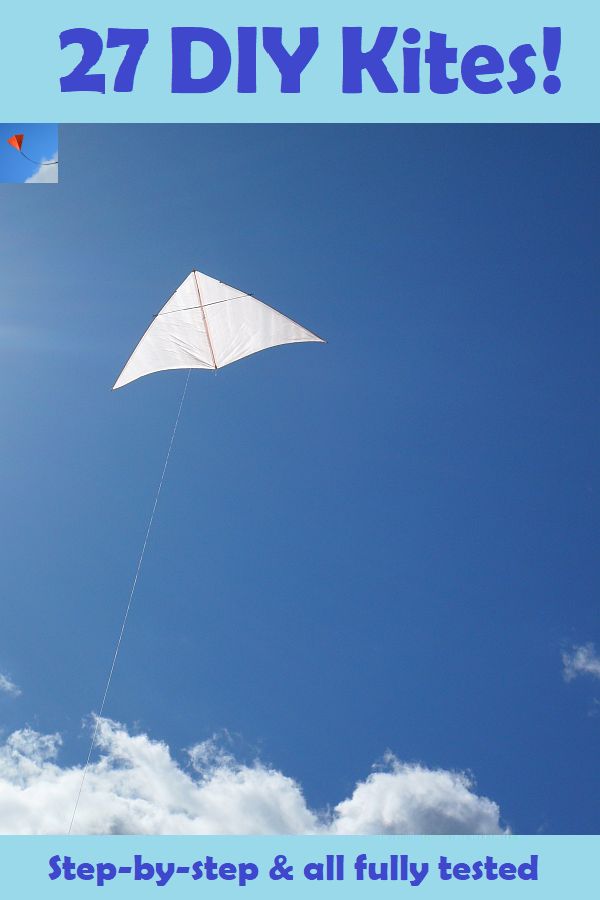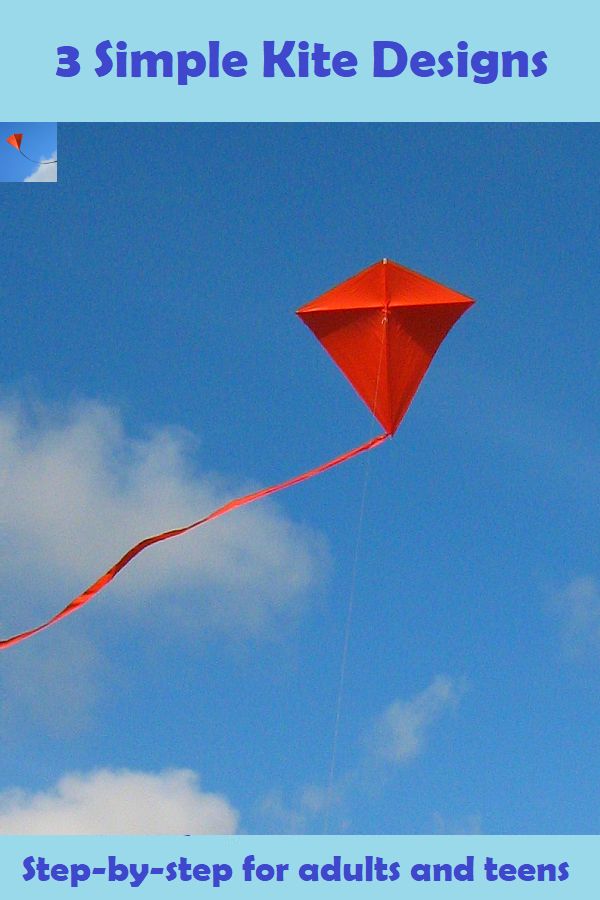- Home Page
- Soft Kites
How to Make Soft Kites
Plastic and Tape—That's It!
If you want to know how to make soft kites, you have come to a good place.
These designs are not as quick and simple to make as the Simple Series kites elsewhere on this site. However, they have the considerable advantage of not requiring any rigid spar material. There's a photo of each one further down this page.
No sticks or rods made from dowel, bamboo, fiberglass, carbon, or anything else need to be found.
In fact, it's quite possible that enough tape and plastic is already sitting in cupboards around your house to make a high-flying kite—or three!
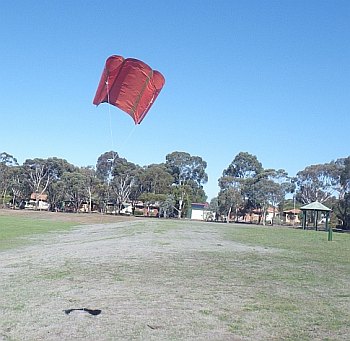 The first MBK Soft Sled
The first MBK Soft SledCheck the section headings further down this page for info on the
- MBK Soft Sled
- MBK Parasail
- MBK Parafoil
- MBK Parachute
- MBK Octopus—yes, a genuine inflatable octopus, writhing tubular tails and all!
Each section below is dedicated to one soft-kite design, which includes a link to a Flight Report. That page includes a video and several large photos of the original kite doing its thing.
I have tried to be generous in my estimates of construction time, below. You might do them quicker!
Enjoy learning how to make soft kites.
The MBK Soft Sled
Construction time: about 3 hours.
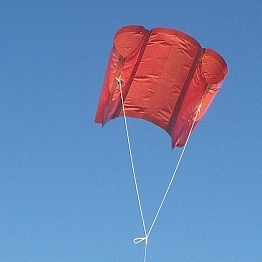 MBK Soft Sled
MBK Soft SledThis design was inspired by the classic Pocket Sled but has several small differences. That's not to mention some large ones: the different scale, materials, and construction methods.
Here are the free step-by-step instructions.
The same day the second prototype was made, I went out to fly it. The sled flew very well, high up in gusty moderate winds on a "blue" day—hardly a cloud in sight.
Read about this kite's first flights. The photos and video in there were taken on the day. Check them out!
Being pretty simple, this design is a good intro to making soft kites the MBK way.
The MBK Parasail
Construction time: about 6 hours.
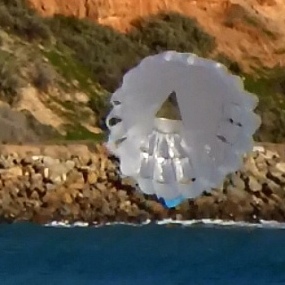 MBK Parasail
MBK ParasailYou know, those huge parachute-like things that haul tourists off beaches and into the air behind a speedboat. Now you will be able to make a much smaller version and fly it like a kite!
Here are the free step-by-step instructions.
The second prototype was taken down to a nearby beach, just a few days after it was completed. Although sunlight eventually dwindled, the kite flew successfully in smooth wind and sunshine. A couple of bridle lines were shortened just a bit to trim the kite for its best and longest flight.
Read about the parasail flying over beach sand. See this kite from various angles in the video and large photos in there.
The MBK Parafoil
Construction time: about 5 hours.
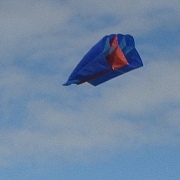 MBK Parafoil
MBK ParafoilEverybody's seen a parafoil these days. There are no rigid spars, just squarish cells of cloth, open at the front and closed at the back. Recall your last visit to a kite festival, if you've been to one. I'll bet there were parafoils everywhere, big and small. My design is toward the small end of the size range, but it is still a genuine flat-parafoil kite.
Testing has confirmed that this MBK version has a very useful wind range. That is, the range of wind speeds in which the kite will stay up. So there shouldn't be too many days on which you can't fly.
Here are the free step-by-step instructions.
The first prototype barely flew. The second did better but tended to collapse on launch and needed some mods. Number three proved it would stay up in light winds close to a beach. A couple of days later, it proved itself again at the other extreme—rough, fresh winds at an inland location. However, it was not what you would call a smooth flyer.
Read about the parafoil flying in light winds.
Finally, after more fiddling about with the size and shape of its keels, number three started flying "like a bought one"!
Read about the parafoil riding gusty moderate winds.
There's a video and three big gallery photos with each of those last two links.
The MBK Parachute
Construction time: about 11 hours.
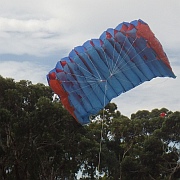 MBK Parachute
MBK ParachuteHave you ever seen a skydiver zooming in to land, under a rectangular canopy? That's called a "sport parachute," and the MBK kite version looks very similar—right down to the little drogue dangling behind. See if you can spot the blob of orange against the trees in the photo over there.
This MBK kite is able to handle quite fresh breezes. So keep it handy for when your other kites give up and start looping around or going way over to one side. Useful! And, of course, there's no rigging to do compared to, say, a box kite.
Here are the free step-by-step instructions.
As with some of my other soft designs, the first two prototypes weren't particularly satisfactory. The main issue was getting the bridling right so the kite would stay inflated and fly stable.
Finally, good flying characteristics were achieved. The little foil turned out to have a great wind range.
Read about the parachute kite flying over rocks, in a light-to-gentle-strength breeze near the surf. Plus see video and big gallery photos taken on the day.
And finally, here's the last design in this series on how to make soft kites:
The MBK Octopus
Construction time: about 14 hours.
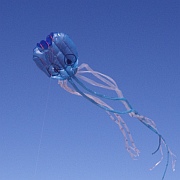 MBK Octopus
MBK OctopusIf you have ever been to a large kite festival, it's almost certain that a large octopus would have taken to the sky at some point. The MBK version is, of course, a lot smaller but retains much of the attraction of its huge cousins!
Once it's up, the MBK octopus is quite steady in the air and doesn't pull too hard. An older kid would be able to stay in control even in moderate winds.
People walking past will gawk at the wide-eyed creature with flowing, flailing tentacles. Guaranteed! It's a definite head-turner, this kite.
Here are the free step-by-step instructions.
As usual, three prototypes were required, and the bridle was redone on the last one as well. Designing soft kites is not for the impatient.
Read about when this octopus was boxed in at the beach, flying high under an overcast sky. There's video and six huge gallery photos in there too.
Wind-Speed Handy Reference
Light Air
1-5 kph
1-3 mph
1-3 knts
Beaufort 1
Light breeze
6–11 kph
4–7 mph
4–6 knts
Beaufort 2
Gentle ...
12–19 kph
8–12 mph
7–10 knts
Beaufort 3
Moderate ...
20–28 kph
13–18 mph
11–16 knts
Beaufort 4
Fresh ...
29–38 kph
19–24 mph
17–21 knts
Beaufort 5
Strong ...
39–49 kph
25–31 mph
22–27 knts
Beaufort 6
High Wind
50-61 kph
32-38 mph
28-33 knts
Beaufort 7
Gale
62-74 kph
39-46 mph
34-40 knts
Beaufort 8
More about Soft Kites
I've noticed that experienced kite flyers often gravitate toward soft designs. These can often be very large and expensive ones, but that's not where we're at here. Anyway—soft kites, pound for pound or kilo for kilo, are just less work out on the flying field!
Using my publications on how to make soft kites should be fun for
just about any age group. Having said that, I might eventually include
hints and tips for scaling the designs either up or down. So, tiny
kites for tiny tot kite enthusiasts and huge ones for serious kite flyers.
Interestingly, scaling is not as straightforward for soft kites as it is for sparred ones. One thing you can be sure of though—I will suffer first, through a failed kite or two before finding the secret to making it work.




